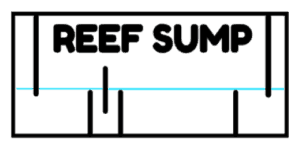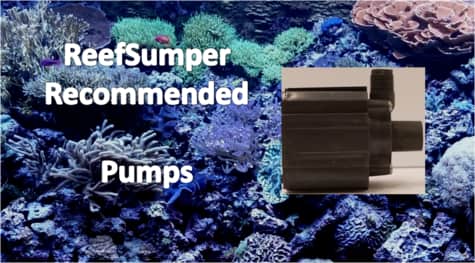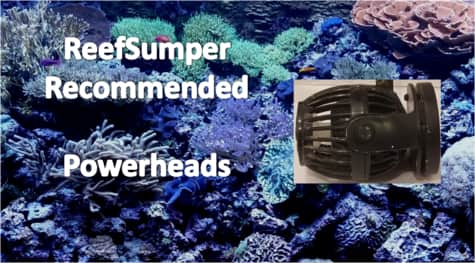
The amount of flow necessary through a saltwater aquarium sump is highly debated across the hobby. There are many ways to calculate different flow rates that may be good for each reef keeper’s individual reef aquarium. Today we look at different methodologies for determining the right flow rates through your saltwater aquarium sump for a healthy and thriving reef tank.
How much flow is needed through a saltwater aquarium sump? A 3-5 times water turnover rate through the sump is generally a good target to shoot for. There are different opinions on the subject and higher rates including a flow rate of 10 times through the sump will also work.
This article will look at ways to calculate flow rates and things to consider when setting up the right flow rate through your sump.
Calculating Flow Rate Through the Sump
Calculating the flow rate through the sump is not too difficult of a task to get a close estimate of your flow rate. The first consideration to consider is your drain line. The size of your drain line will determine the maximum amount of gallons that can be drained from the display tank into the sump. The type of pipe you use will also have an impact on the gallons per hour drain rate. You will also lose some gallons per hour at any point where water is diverted in different directions such as through an elbow or is restricted like going through a narrower section of pipe. A ball valve or gate valve can be used on the drain line to give you the ability to dial-up or down drain rates through the valve. Here is a chart on drain rates drained by only gravity through common schedule 40 PVC pipe.
| Schedule 40 Pipe Size | Gallons Per Hour (GPH) |
| 1/2” | 420 GPH |
| 3/4” | 660 GPH |
| 1” | 960 GPH |
| 1.25” | 1500 GPH |
| 1.5” | 2100 GPH |
| 2” | 3300GPH |
| 2.5” | 4800 GPH |
| 3” | 8400 GPH |
One important factor to keep in mind when considering flow rates through the sump is to make sure to not size your return pump larger than the drain line can handle. If your return pump is pumping faster than the display is draining, the water level in the sump will be low and the return pump will suck air into the return line resulting in microbubbles in the display tank, this setup will not work. You can oversize your pump, but you want to have the flexibility to dial up and downflow at different points of your flow loop. This can be done by having a variable speed return pump and gate/ball valves on the return and drain lines. In my setups, I always use an adjustable return pump and a gate valve on both the return and drain lines. Gate valves cost more than ball valves but allow you to make micro-adjustments to perfectly dial in your flow through the sump and back into the tank.
Flow Rates to Consider in Your Saltwater Aquarium System
The flow rate through the sump is a hotly debated subject in the marine aquarium hobby and there are great logical reasons for faster vs. slower flow rates through the sump.
Faster Flow Rates Through the Sump
One calculation that has been in the hobby for a long time is the 10x flow rate calculation. The calculation is set up to determine a ten times water turnover rate per hour in the system. You simply take 10 times the gallons of water in the system to get ten times the turnover per hour in the system. I consider anything greater than 10x a fast flow rate through the sump.
Example: (75 gallon tank + 25 gallon sump) X 10 = 1000 gallon per hour flow rate
Potential Advantages of Faster Flow Rates
There are a few advantages to having a high flow rate through the sump. With a high flow rate, organic waste may be continuously suspended in the water column having less of a chance to settle and more of a chance to be removed through filtration in the sump. Aeration is also important to a reef tank and the constant mixing of water and air during turnover has the potential to increase aeration levels. With a higher return rate, the return lines can help keep water moving throughout the display tank. The use of Loc Line the out of the return can be utilized to direct flow to different spots in the tank.
Slower Flow Rates Through the Sump
Using the same calculation as the 10x calculation, a slower rate to consider is in the 3-5x range. Slower rates through the sump have some potential advantages and while potentially losing some of the advantages of the faster flow as outlined above. One thought with using a faster rate through the sump is that the water is moving through the sump before it is effectively filtered by the skimmer resulting in unfiltered water returning back into the display tank. Getting closer to the gallons per hour of the skimmer could mean that water is filtered more before moving back into the tank. For water movement within the display tank, the return line is probably not the best option. Powerheads are far more effective in moving water within the display tank. Powerhead technology has improved to the level where complete random water movement and limited dead spots are possible without factoring in the return line. Modifying the return line for flow might just be reducing your overall turnover.
Matching to Protein Skimmer Output to Flow Rate Another Consideration
Another method to consider is to try and match the output of your skimmer to the flow rate moving through the sump. Skimmers use a pump that has its own capability of moving water through itself expressed in gallons per hour. The idea of matching the skimmer and flow rate through the sump is that the skimmer will pick up most of the water filtering it before it returns to the display tank.
What Flow Rate I Use in My Systems and Recommend
In my time in the hobby, I’ve seen incredible reef tanks using both fast and slow flow rates through the sump. In my opinion, both methods work, and flow rate through the sump is almost a secondary consideration in the optimization of reef keeping. If you stay away from extreme flow rates that are too slow or too fast you should be ok. With that said here is the recipe I use for flow rate through the systems that I have in my own tanks that have produced healthy thriving reef tanks.
I usually will shoot for a 3-5 times turnover flow rate through my sump. This is considered on the lower side of the turnover rate. I take the gallons of the tank and sump and multiply by 5 to get a target. When choosing a return pump I will then consider the skimmer I will be using and will choose a return pump that is in the 3-5 times turnover rate, is at least capable of keeping up with the skimmer, and is below the maximum drain capability. Hitting on these three points and having gate valves and pump adjustability will give you the ability to dial in the right flow rate through the sump to effectively clean your water. Using those guides I’ve found has some great advantages that help in my personal reef keeping.
Cost Advantage by Using a Smaller Return Pump
By moving less water through your sump you can use a smaller-sized pump. A smaller size pump will generally cost less than a larger pump. Return pumps are on 24×7 except during maintenance. The constant mechanical operation of the return pump means that it has more potential to break and require replacement. When this happens a smaller pump is going to have less impact on your wallet. If you are using a variable speed pump you can run it at less than its maximum gallons per hour rate. When you can run your pump at a level less than its maximum gallons per hour rate you should see an increased life span in the return pump. If your return pump fails, remember to check the impeller, often this is the piece that malfunctions and can be less costly to replace versus replacing the entire pump.
Flexibility and Sound Advantages
A smaller-sized pump has the advantage of being smaller in physical size. With smaller dimensions, the return pump may fit better in your sump. More room in your sump is always a good thing as it allows for more equipment options and overall flexibility. Depending on your sump setup, your return chamber might only allow a smaller-sized pump. One of the biggest advantages of a smaller sized pump is its lower noise. I like to enjoy the look of my reef tank and sump area and not hear it as much as possible. A smaller pump will produce less noise than a larger return pump. There are ways to dampen return pump noise, but using a smaller pump is often the most effective.
Conclusion
Whether you choose a fast or slow flow rate through your sump setting up your plumbing and return pump correctly should yield positive results in your saltwater aquarium. When you consider your drain, return line, return pump, skimmer capability, and build flexibility in your setup with gate valves and pump adjustability you will be able to dial in the right settings for your tank.
Related Questions
Is it possible to measure the exact flow rate in my system? A flow meter can be used in line with plumbing usually on the return line to measure flow through a pipe. Neptune Systems makes a flow meter that can be plumbed on the return line and connected to the Apex Controller to measure flow constantly.
What’s the difference between AC and DC return pumps? AC stands for alternating current and DC stands for direct current electricity. AC pumps run at their constant maximum speed and flow rate with adjustability happening as head pressure on the pump. DC pumps use direct current electricity through a controller which allows the pump to use less power and variably adjust its flow rate. Where DC return pumps have a lot of operating advantages AC pumps do have their own advantages. AC pumps are cheaper and quite reliable overall.


